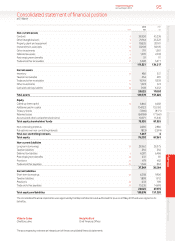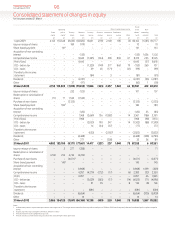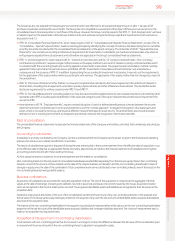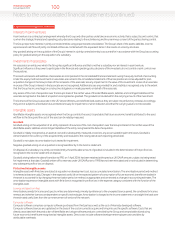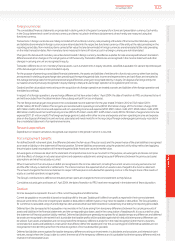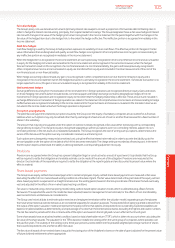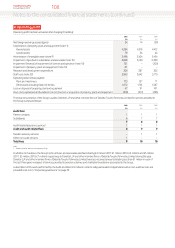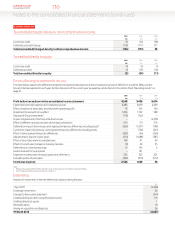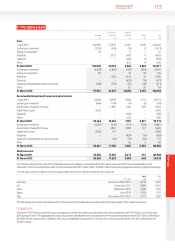Vodafone 2012 Annual Report Download - page 105
Download and view the complete annual report
Please find page 105 of the 2012 Vodafone annual report below. You can navigate through the pages in the report by either clicking on the pages listed below, or by using the keyword search tool below to find specific information within the annual report.
Business review Performance Governance Financials Additional information
103
Vodafone Group Plc
Annual Report 2012
Foreign currencies
The consolidated nancial statements are presented in sterling, which is the parent company’s functional and presentation currency. Each entity
inthe Group determines its own functional currency and items included in the nancial statements of each entity are measured using that
functional currency.
Transactions in foreign currencies are initially recorded at the functional currency rate prevailing at the date of the transaction. Monetary assets
andliabilities denominated in foreign currencies are retranslated into the respective functional currency of the entity at the rates prevailing on the
reporting period date. Non-monetary items carried at fair value that are denominated in foreign currencies are retranslated at the rates prevailing
onthe initial transaction dates. Non-monetary items measured in terms of historical cost in a foreign currency are not retranslated.
Changes in the fair value of monetary securities denominated in foreign currency classied as available-for-sale are analysed between translation
differences and other changes in the carrying amount of the security. Translation differences are recognised in the income statement and other
changes in carrying amount are recognised inequity.
Translation differences on non-monetary nancial assets, such as investments in equity securities, classied as available-for-sale are reported as part
of the fair value gain or loss and are included in equity.
For the purpose of presenting consolidated nancial statements, the assets and liabilities of entities with a functional currency other than sterling
areexpressed in sterling using exchange rates prevailing at the reporting period date. Income and expense items and cash ows are translated at
theaverage exchange rates for the period and exchange differences arising are recognised directly in equity. On disposal of a foreign entity, the
cumulative amount previously recognised in equity relating to that particular foreign operation is recognised in prot or loss.
Goodwill and fair value adjustments arising on the acquisition of a foreign operation are treated as assets and liabilities of the foreign operation and
translated accordingly.
In respect of all foreign operations, any exchange differences that have arisen before 1 April 2004, the date of transition to IFRS, are deemed to be nil
and will be excluded from the determination of any subsequent prot or loss on disposal.
The net foreign exchange gain recognised in the consolidated income statement for the year ended 31 March 2012 is £702 million (2011:
£1,022million, 2010: £35 million). The net gains are recorded within operating income (2012: £34 million charge, 2011: £14 million charge, 2010:
£29million credit), other income and expense and non-operating income and expense (2012: £681 million credit, 2011: £630 million credit, 2010:
£84 million credit), investment and nancing income (2012: £55 million credit, 2011: £405 million credit, 2010: £78 million charge) and income tax
expense (2011: £1 million credit). The foreign exchange gains included within other income and expense and non-operating income and expense
arise on the disposal of interests in joint ventures, associates and investments from the recycling of foreign exchange gains previously recorded in
the consolidated statement of comprehensive income.
Research expenditure
Expenditure on research activities is recognised as an expense in the period in which it is incurred.
Post employment benets
For dened benet retirement plans, the difference between the fair value of the plan assets and the present value of the plan liabilities is recognised
as an asset or liability on the statement of nancial position. Scheme liabilities are assessed using the projected unit funding method and applying
the principal actuarial assumptions at the reporting period date. Assets are valued at market value.
Actuarial gains and losses are taken to the statement of comprehensive income as incurred. For this purpose, actuarial gains and losses comprise
both the effects of changes in actuarial assumptions and experience adjustments arising because of differences between the previous actuarial
assumptions and what has actually occurred.
Other movements in the net surplus or decit are recognised in the income statement, including the current service cost, any past service cost
andthe effect of any curtailment or settlements. The interest cost less the expected return on assets is also charged to the income statement.
Theamount charged to the income statement in respect of these plans is included within operating costs or in the Group’s share of the results of
equity accounted operations as appropriate.
The Group’s contributions to dened contribution pension plans are charged to the income statement as they fall due.
Cumulative actuarial gains and losses at 1 April 2004, the date of transition to IFRS, have been recognised in the statement of nancial position.
Taxation
Income tax expense represents the sum of the current tax payable and deferred tax.
Current tax payable or recoverable is based on taxable prot for the year. Taxable prot differs from prot as reported in the income statement
because some items of income or expense are taxable or deductible in different years or may never be taxable or deductible. The Group’s liability
forcurrent tax is calculated using UK and foreign tax rates and laws that have been enacted or substantively enacted by the reporting period date.
Deferred tax is the tax expected to be payable or recoverable in the future arising from temporary differences between the carrying amounts of
assets and liabilities in the nancial statements and the corresponding tax bases used in the computation of taxable prot. It is accounted for using
the statement of nancial position liability method. Deferred tax liabilities are generally recognised for all taxable temporary differences and deferred
tax assets are recognised to the extent that it is probable that taxable prots will be available against which deductible temporary differences can
beutilised. Such assets and liabilities are not recognised if the temporary difference arises from the initial recognition (other than in a business
combination) of assets and liabilities in a transaction that affects neither the taxable prot nor the accounting prot. Deferred tax liabilities are not
recognised to the extent they arise from the initial recognition of non-tax deductible goodwill.
Deferred tax liabilities are recognised for taxable temporary differences arising on investments in subsidiaries and associates, and interests in joint
ventures, except where the Group is able to control the reversal of the temporary difference and it is probable that the temporary difference will not
reverse in the foreseeable future.




